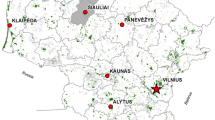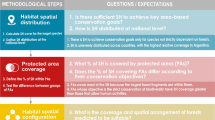Abstract
The production of timber from native forests is presently one of the most controversial land management issues in Australia. Part of this controversy results from the potential impacts of forestry practices on forest-dependent fauna, particularly those that are rare and endangered, such as Leadbeater's Possum Gymnobelideus leadbeateri McCoy, in the forests of central Victoria, south-eastern Australia. A significant proportion of the highly limited distribution of this species overlaps with some of the most valuable wood production forests in Australia within which extensive clearfelling operations are employed to produce timber and pulpwood. These operations can destroy the habitat of G. leadbeateri. The Victoria government agency that is responsible for forest and wildlife management has devised a forest zoning system as part of the management strategies to conserve G. leadbeateri within timber production areas. This is designed to partition the forest into three types of areas: (1) where the conservation of G. leadbeateri is a priority, (2) where wood production is a priority, and, (3) where both land uses are a joint priority. The classification of areas of forest where the conservation of G. leadbeateri is the primary land use is based on an understanding of the habitat requirements of the species. The results of recent field studies, where statistical models of the habitat requirements of G. leadbeateri have been developed and their performance subsequently tested using a new dataset, highlights the need for a new basis to guide the classification of areas for the conservation of the species within wood production forests. We describe a method for devising a forest management zoning system that is based on a statistical model of the habitat requirements of G. leadbeateri and which will better integrate wood production and the conservation of the species. This procedure accounts for the uncertainty in the statistical model and, in turn, reduces the risk that areas where G. leadbeateri occurs are logged, whilst ensuring that other areas are not unnecessarily excluded from timber harvesting.
Similar content being viewed by others
References
ClarkT.W. and HarveyA.H.: 1988, ‘Implementing endangered species recovery policy’, Endangered Species Update 5, 35–39.
ClarkT.W., WarnekeR.M. and GeorgeG.G.: 1990, ‘Management and conservation of small populations’, In: T.W.Clark and J.H.Seebeck (eds.), Management and Conservation of Small Populations, Chicago Zoological Society, Chicago, pp. 1–18.
The Commonwealth of Australia: 1992, National Forest Policy Statement, Advance Press, Perth, Australia, 56 pp.
DaveyS.M.: 1989, ‘Thoughts towards a forest wildlife management strategy’, Australian Forestry 52, 56–67.
Department of Conservation, Forests and Land: 1989, Code of Practice, Code of Forest Practices for Timber Production, Revision No. 1, May 1989, Department of Conservation, Forests and Lands, Melbourne, Australia.
Government of Victoria: 1986, Government Statement No. 9, Timber Industry Strategy, Government Printer, Melbourne, Australia, 103 pp.
Government of Victoria: 1988, Flora and Fauna Guarantee Act No. 47 of 1988, Government Printer, Melbourne, Australia, 103 pp.
GruenF., LeslieA. and SmithA.P.: 1989, ‘Inquiry into the proposed trial of the value adding utilization system in the Central and East Gippsland Forest Management areas, under the Environmental Assessment Act’, Ministry for Planning and Environment, Melbourne, Australia.
HollingC.S.: 1973, ‘Resilience and stability of ecological systems’, Annual Review of Ecology and Systematics 4, 1–23.
HollingC.S. (ed.): 1978, Adaptive Environmental Assessment and Management, International Series on Applied Systems Analysis 3, International Institute for Applied Ssystems Analysis, John Wiley and Sons, Toronto, Ontario.
IUCN Red List of Threatened Animals: 1993, World Conservation Monitoring Centre, Cambridge, UK, 154 pp.
Land Conservation Council: 1993, ‘Proposed recommendations, Melbourne Area, District 2 Review’, Land Conservation Council, Melbourne, Australia.
LindenmayerD.B.: 1992a, ‘The ecology and habitat requirements of arboreal marsupials in the montane ash forests of the Central Highlands of Victoria, a summary of studies’, Value Adding and Silvicultural Systems Program, VSP Report No. 6, Native Forest Research, Department of Conservation and Environment, Melbourne, Australia, 15 pp.
LindenmayerD.B.: 1992b, ‘Some impacts on arboreal marsupials of clearfelling on a 80–120 year rotation in Mountain Ash, Eucalyptus regnans forests in the Central Highlands of Victoria’, Victorian Naturalist 109, 181–186.
LindenmayerD.B.: 1994, ‘The impacts of timber harvesting on arboreal marsupials at different spatial scales and its implications for ecologically sustainable forest use and nature conservation’, Australian Journal of Environmental Management 1, 56–68.
LindenmayerD.B., TantonM.T. and NortonT.W.: 1990a, ‘A test case for integrated forestry, timber production and the conservation of a rare animal, Leadbeater's Possum, in Victoria’, Search 21, 156–159.
LindenmayerD.B., CunninghamR.B., TantonM.T. and SmithA.P.: 1990b, ‘The conservation of arboreal marsupials in the montane ash forests of the Central Highlands of Victoria, southeast Australia, II, The loss of trees with hollows and its implications for the conservation of Leadbeater's Possum Gymnobelideus leadbeateri McCoy’, Marsupialia: Petauridae, Biological Conservation 54, 133–145.
LindenmayerD.B., CunninghamR.B., TantonM.T., SmithA.P. and NixH.A.: 1990c, ‘The habitat requirements of the Mountain Brushtail Possum and the Greater Glider in the montane ash-type eucalypt forests of the Central Highlands of Victoria’, Australian Wildlife Research 17, 467–478.
LindenmayerD.B., NixH.A., McMahonJ.P., HutchinsonM.F. and TantonM.T.: 1991a, ‘Bioclimatic modelling and wildlife conservation—a case study on Leadbeater's Possum, Gymnobelideus leadbeateri’, Journal of Biogeography 18, 371–383.
LindenmayerD.B., CunninghamR.B., TantonM.T., NixH.A. and SmithA.P.: 1991b, ‘The conservation of arboreal marsupials in the montane ash forests of the Central Highlands of Victoria, south-east Australia, III, The habitat requirements of Leadbeater's Possum, Gymnobelideus leadbeateri and models of the diversity and abundance of arboreal marsupials’, Biological Conservation 56, 295–315.
LindenmayerD.B., TantonM.T., LingaT. and CraigS.A.: 1991c Public participation in stagwatching surveys for a rare mammal-applications for environmental education’, Australian Journal of Environmental Education 7, 63–70.
LindenmayerD.B., CunninghamR.B., TantonM.T., SmithA.P. and NixH.A.: 1991d, ‘Characteristics of hollow-bearing trees occupied by arboreal marsupials in the montane ash forests of the Central Highlands of Victoria, south eastern Australia’, Forest Ecology and Management 40, 289–308.
LindenmayerD.B., CunninghamR.B., NixH.A., TantonM.T. and SmithA.P.: 1991e, ‘Predicting the abundance of hollow-bearing trees in montane ash forests of south-eastern Australia’, Australian Journal of Ecology 16, 91–98.
LindenmayerD.B. and NortonT.W.: 1993 The conservation of Leadbeater's Possum in south-eastern Australia and the Spotted Owl in the Pacific Northwest of the U.S.A., management issues, strategies and lessons’, Pacific Conservation Biology 1, 13–18.
LindenmayerD.B., LacyR.C., ThomasV.C. and ClarkT.W.: 1993a, ‘Predictions of the impacts of changes in population size and of environmental variability on Leadbeater's Possum, Gymnobelideus leadbeateri McCoy using population viability analysis: an application of the computer program VORTEX’, Wildlife Research 20, 67–86.
LindenmayerD.B., CunninghamR.B. and DonnellyC.F.: 1993b, ‘The conservation of arboreal marsupials in the montane ash forests of the Central Highlands of Victoria, south-east Australia, IV. The distribution and abundance of arboreal marsupials in retained linear strips (wildlife corridors) in timber production forests’, Biological Conservation 66, 207–221.
LindenmayerD.B., CunninghamR.B., DonnellyC.F., TantonM.T. and NixH.A.: 1993c, ‘The abundance and development of cavities in montane ash-type eucalypt trees in the montane forests of the Central Highlands of Victoria, south-east Australia’, Forest Ecology and Management 60, 77–104.
LindenmayerD.B., CunninghamR.B. and DonnellyC.F.: 1994a, ‘The conservation of arboreal marsupials in the montane ash forests of the Central Highlands of Victoria, south-east Australia, VI, Tests of the performance of models of nest tree and habitat requirements of arboreal marsupials’, Biological Conservation 70, 143–147.
LindenmayerD.B., BoyleS., BurgmanM.B., McDonaldD. and TomkinsB.: 1994c, ‘The sugar and nitrogen content of the gums of Acacia spp. in the mountain ash and alpine ash forests of central Victoria and its potential implications for exudivorous arboreal marsupials’, Australian Journal of Ecology 19, 169–177.
LindenmayerD.B. and LacyR.C.: 1995, ‘Metapopulation viability of Leadbeater's Possum, Gymnobelideus leadbeateri, in fragmented old growth ash forests’, Ecological Applications 5, 164–182.
Lindenmayer, D.B. and Possingham, H.P.: 1994, ‘An extinction risk assessment of Leadbeater's Possum-ranking management options using population viability analysis’, Report to the Australian Nature Conservation Agency, Centre for Resource and Environmental Studies and Endangered Species Unit, 227 pp.
MacfarlaneM.A. and SeebeckJ.H.: 1991, ‘Draft strategies for the conservation of Leadbeater's Possum, Gymnobelideus leadbeateri, in Victoria’, Technical Report Series No. 111, Arthur Rylah Institute for Environmental Research, Department of Conservation and Environment, Melbourne, Australia.
McCullaghP. and NelderJ.A.: 1988, Generalized Linear Models, Chapman and Hall, New York, 511 pp.
MilledgeD.R., PalmerC.L. and NelsonJ.L.: 1991, ‘Barometers of change: the distribution of large owls and gliders in Mountain Ash forests of the Victorian Central Highlands and their potential as management indicators’, In: D.Lunney (ed.), Conservation of Australia's Forest Fauna, Royal Zoological Society of New South Wales, Sydney, Australia, pp. 55–65.
MurphyD.D. and NoonB.D.: 1991, ‘Coping with uncertainty in wildlife biology’, Journal of wildife Management 55, 773–782.
RecherH.F.: 1995, ‘Conservation and management of eucalypt forest vertebrates’, In: R.M.DeGraaf and R.I.Miller (eds.), The Conservation of Wildlife Diversity in Forested Landscapes Around the Globe, Chapman and Hall, London, UK, (in press).
ReckhowK.H.: 1994, ‘Importance of scientific uncertainty in decision making’, Environmental Management 18, 161–166.
Resource Assessment Commission: 1992, Forest and Timber Inquiry, Final Report. Volume 1, Australia Government Printing Service, Canberra, Australia.
Smith, A.P.: 1980, ‘The diet and ecology of Leadbeater's Possum and the Sugar Glider’, Ph.D. thesis, Monash University, Melbourne, Australia.
SmithA.P.: 1984, ‘Diet of Leadbeater's Possum, Gymnobelideus leadbeateri (Marsupialia)’, Australian Wildlife Research 11, 265–273.
SmithA.P. and LindenmayerD.B.: 1988, ‘Tree hollow requirements of Leadbeater's Possum and other possums and gliders in timber production forests of the Victorian Central Highlands’, Australian Wildlife Research 15, 347–362.
SmithA.P. and LindenmayerD.B.: 1992 Forest succession, timber production and conservation of Leadbeater's Possum (Gymnobelideus leadbeateri Marsupialia: Petauridae), Forest Ecology and Management 49, 311–332.
SmithJ. and MacfarlaneM.A.: 1991, ‘Using a Geographic Information System to manage Leadbeater's Possum’, Australian Ranger Bulletin 6, 38–40.
Author information
Authors and Affiliations
Rights and permissions
About this article
Cite this article
Lindenmayer, D.B., Cunningham, R.B. A habitat-based microscale forest classification system for zoning wood production areas to conserve a rare species threatened by logging operations in south-eastern Australia. Environ Monit Assess 39, 543–557 (1996). https://doi.org/10.1007/BF00396167
Issue Date:
DOI: https://doi.org/10.1007/BF00396167




